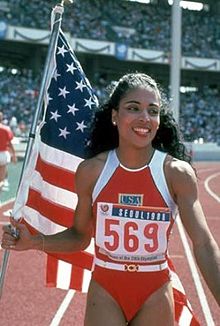At the 1988 Olympic trials, while outfitted in a one-legged purple track suit and sporting four inch fingernails, she set a world record in the 100 meters, running it at 10.49 seconds, knocking more than a quarter of a second off her best-ever time despite not even being one of the country’s best in the event a year earlier.

Flo Jo at the Seoul Olympic Games in 1988
Florence Delorez Griffith grew up in a housing project in the Watts neighborhood of Los Angeles as the seventh of eleven children. From an early age, Griffith enjoyed competition and sought attention. She held handstand competitions, rode around on a unicycle, designed unique clothes for her Barbie doll, wore strange hairdos and owned a trained pet rat. And she was fast. Florence’s father often told a story about taking the kids to the nearby Mojave Desert when she was five and challenging them to chase jackrabbits. Florence caught one. “Jackrabbit” became her nickname.
By age 7, she was competing in track. In high school, she set records in sprints and the long jump. Following graduation, she competed at Cal State Northridge under the legendary sprint coach Bob Kersee and helped them win the national championship in 1978.
But unable to afford college, she dropped out for two years and worked as a bank teller. Kersee, meanwhile, landed an assistant coaching job at UCLA, and was soon able to secure a scholarship for his former star athlete. She enrolled at UCLA in 1980 and, as a junior, won the NCAA 200-meter title.
That same year, she met her future husband, triple jumper Al Joyner, at the U.S. Olympic trials in Eugene, Oregon. Though it would be some time before they dated, it was love at first sight for Joyner. Meanwhile, the 20-year-old Arkansas State athlete pinned her photo up in his dorm, telling his roommate, “That’s the girl I’m going to marry.”
Four years later, they met again at the Olympic trials, this time held in Los Angeles. At the Soviet-boycotted Olympic Games that year, Al Joyner, not a pre-competition favorite, would surprise the world by winning the gold medal in the triple jump. Griffith would win the silver in the 200 meters. Joyner continued his pursuit of Griffith, sending her letters and a promotional photo of himself. Griffith responded in kind. In 1986, Joyner moved to LA ostensibly to train for the ’88 Olympics, but also to be closer to Griffith.
Despite being arguably among the best female athletes in the country, in 1985 Griffith was forced to rejoin the workaday world to make ends meet. She went back to work at the bank, and earned extra income by giving her friends the kind of flashy manicures and hairstyles she would later become famous for sporting herself.
In 1987, Griffith and Joyner married, becoming U.S. track and field’s equivalent of a royal family. Joyner left her longtime trainer Bob Kersee to train with Al Joyner, who put her on a more disciplined regimen. No more staying up late braiding hair, no more McDonald’s. He made her concentrate more on weight training, doing exercises then more common for male athletes.
The results were stunning – too stunning for some. She’d gained a lot of muscle mass and definition, and whispers started surfacing about steroids, an accusation that drove husband-coach Joyner crazy but that she more or less managed to shrug off. At the 1988 Olympic trials, while outfitted in a one-legged purple track suit and sporting four inch fingernails, she set a world record in the 100 meters, running it at 10.49 seconds, knocking more than a quarter of a second off her best-ever time despite not even being one of the country’s best in the event a year earlier. The result was not without controversy – today, most admit it was almost certainly wind-aided – but her drug tests came back negative and the record stood. It still stands to this day.